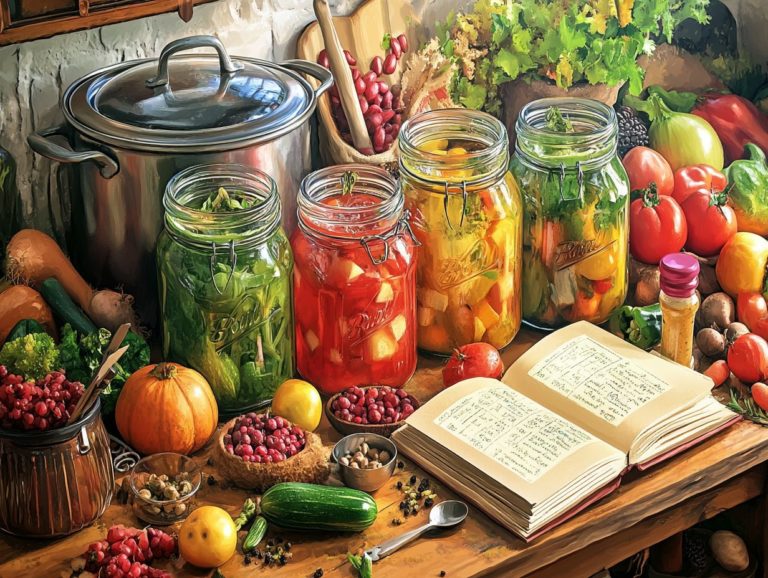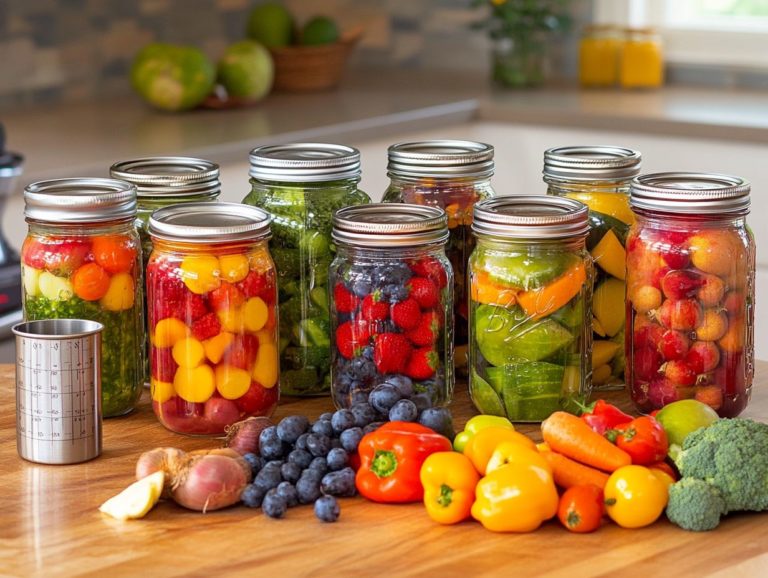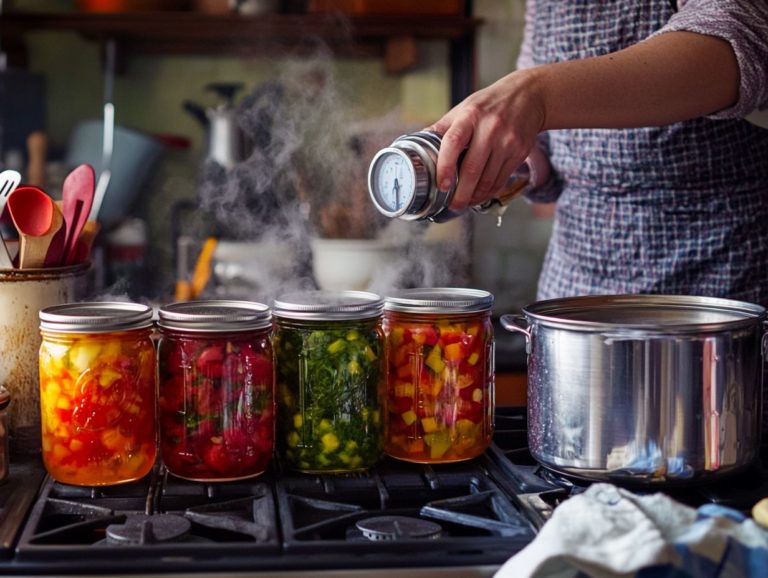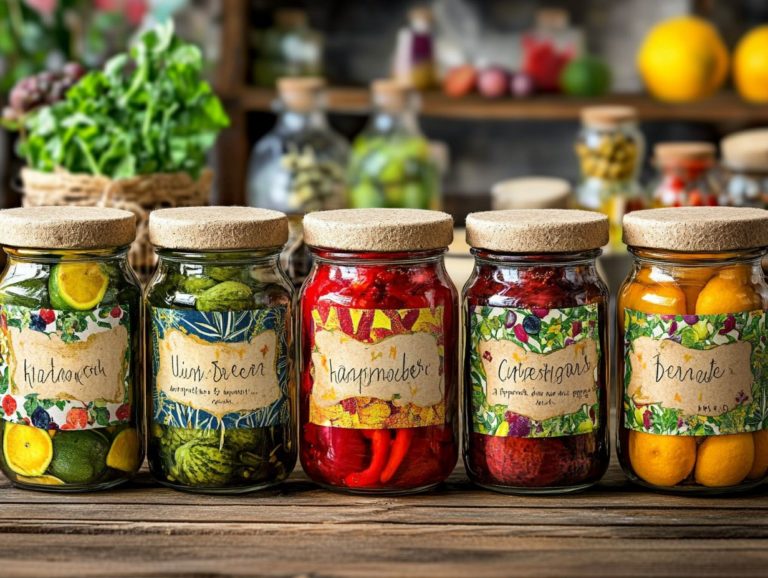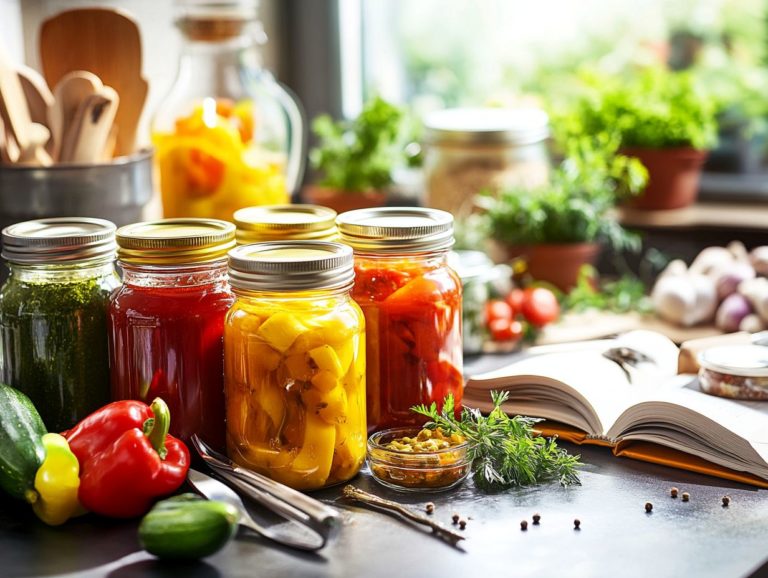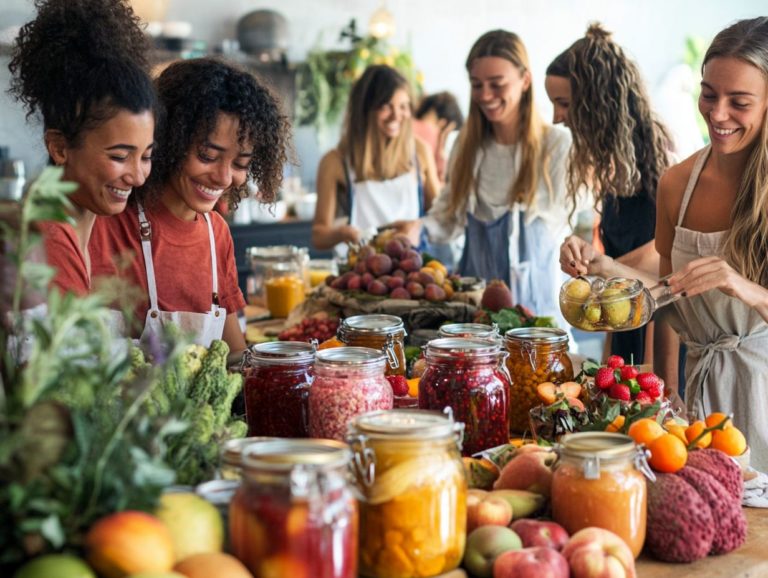Best Practices for Canning Pickles
Pickling is not just about keeping food fresh it’s an exciting culinary adventure! It s an art form that has been revered for centuries.
With everything from crunchy cucumbers to zesty spices, this remarkable technique transforms fresh produce into tangy delights that can elevate any meal. You ll uncover the rich history and purpose behind pickling, learn how to select the perfect cucumbers, and follow a comprehensive step-by-step guide for canning.
You will also discover invaluable tips on flavoring, storing, and troubleshooting common pickling challenges, ensuring that your culinary creations are nothing short of a triumph.
Jump into the thrilling world of pickling today and unlock the secrets to delicious jars of goodness that will tantalize your taste buds!
Contents
Key Takeaways:
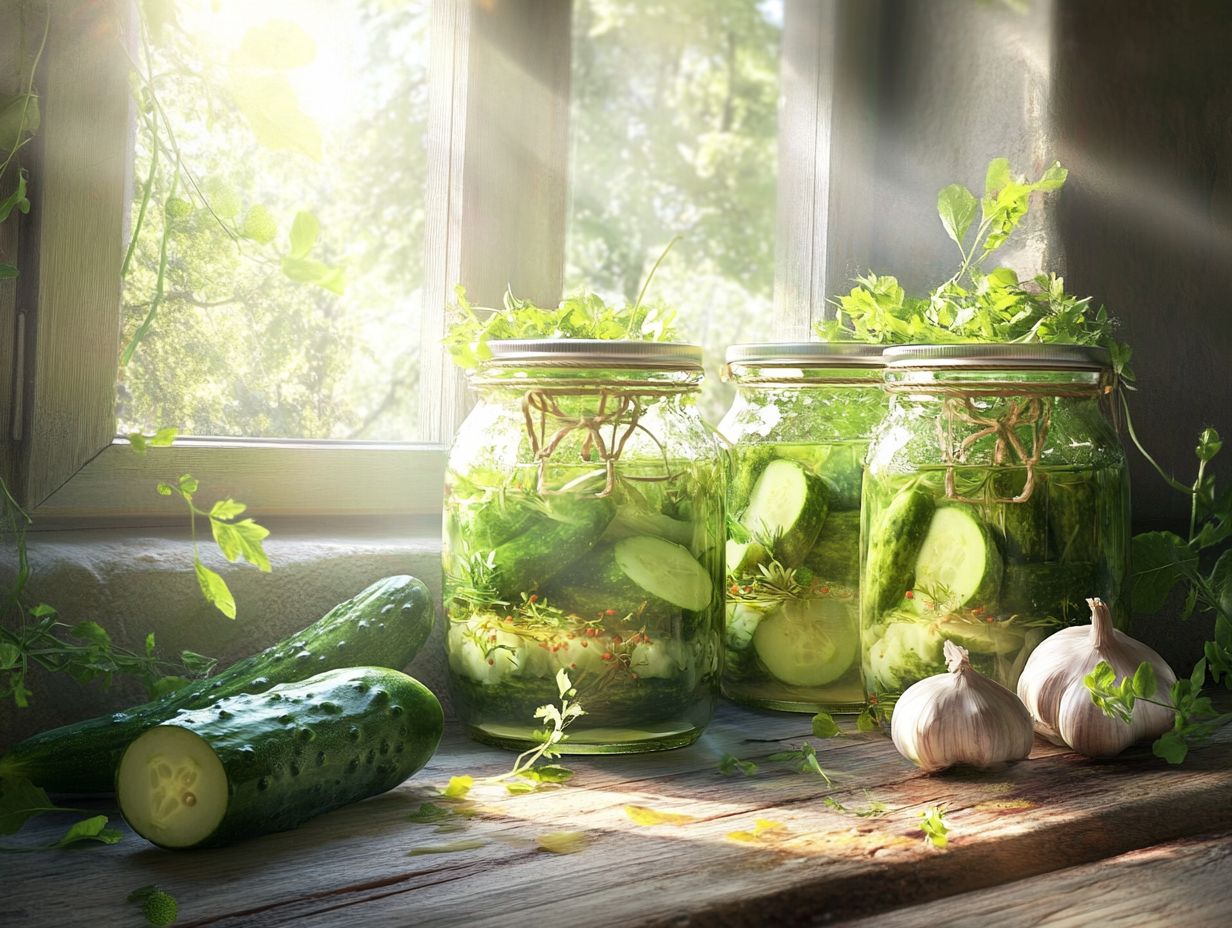
- Choose the right type of cucumber for pickling, like Kirby or Persian, for the best texture and flavor.
- Follow a step-by-step guide to prepare pickles safely and avoid common issues.
- Store pickles in a cool, dark place and serve them carefully to maintain safety and flavor.
The Art of Pickling
The art of pickling is a long-standing practice that allows you to transform fresh produce into tangy, flavorful delights, preserving fruits and vegetables long after their harvest season has concluded.
Whether you re crafting crunchy dill pickles with Kirby cucumbers or quick pickles infused with garlic and fresh dill, mastering this culinary technique unveils a world of possibilities for elevating your meals.
From the meticulous selection of ingredients like kosher dill and pickling spices to the careful process of sealing jars and ensuring proper storage, your journey into pickling becomes both an art and a science, connecting you to the rich history of food preservation.
History and Purpose of Pickling
The history of pickling stretches back thousands of years, initially serving as a practical method for preserving food through fermentation and brining. This technique not only extends the shelf life of fresh produce but also elevates its flavor profile.
Various cultures have embraced and tailored pickling methods over the centuries. Ancient civilizations, such as the Mesopotamians, utilized brine to preserve cucumbers, laying the foundation for a myriad of regional recipes. In Asia, innovative pickling techniques emerged, such as those based on soy sauce and vinegar, giving rise to iconic dishes like kimchi in Korea and pickled ginger in Japan.
The primary aim of these methods has remained consistent: food preservation, enabling communities to store their seasonal harvests and minimize waste. On top of that, the health benefits of pickled foods are quite compelling. Often rich in probiotics good bacteria that promote gut health they aid digestion, making them an essential component of diets around the globe.
Choosing the Right Pickling Cucumbers
Selecting the right cucumbers is pivotal for your pickling success; the texture, flavor, and size of the cucumbers will directly influence the final outcome of your pickles. Kirby cucumbers, with their firm skin and crisp texture, are often your best bet for homemade pickles, delivering that satisfying crunch that beautifully complements the tangy brine.
By sourcing these fresh cucumbers from local farmers markets, you not only ensure quality but also champion sustainable agriculture. Understanding the ideal qualities of a pickling cucumber such as size, color, and freshness is essential for achieving stellar results in your canning endeavors.
Types of Cucumbers and Their Qualities
You ll find several types of cucumbers perfect for pickling, with Kirby cucumbers leading the pack. Their crisp texture and optimal size make them the go-to choice for canning.
Don t overlook other varieties like Persian cucumbers, which bring their own unique charm. These tender cucumbers have a thinner skin and a delightful sweetness, making them ideal for quick pickles. On the other hand, English cucumbers, with their long and smooth appearance, can produce a more delicate pickle that offers a refreshing taste. They do require a bit more care in preparation.
Each cucumber type has distinct flavor profiles. These textures enrich the overall essence of the pickle. From the satisfying crunch of Kirby cucumbers to the mild sweetness of Persians, these nuances are essential for achieving the perfect balance of taste and crunch every pickle enthusiast craves.
Preparing and Processing Pickles
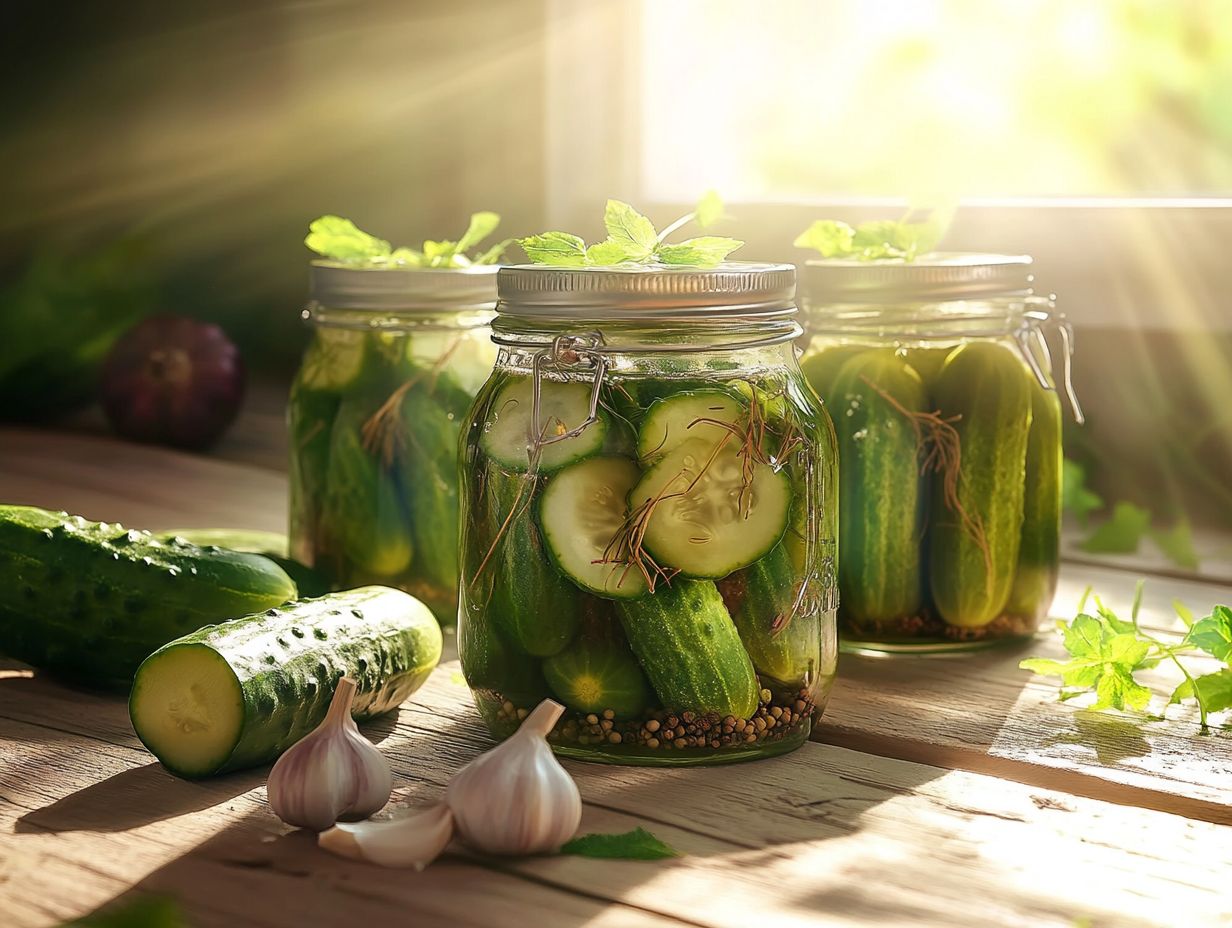
Preparing and processing pickles entails a careful series of steps that guarantee the safety and longevity of your homemade preserves. To ensure success, it’s essential to follow tips for safe canning practices, starting with selecting high-quality canning jars and choosing the right pickling method.
The water bath canning technique is one of the most effective methods for preserving pickles. This method involves submerging sealed jars in boiling water, which effectively kills harmful bacteria. For those interested in this method, here are some essential tips for canning vegetables at home.
Ensuring that your jars are thoroughly cleaned and properly sealed is crucial for successful preservation. This allows you to savor those delicious pickles long after the harvest season has come to a close.
Step-by-Step Guide to Canning Pickles
Canning pickles demands a systematic approach, beginning with the preparation of your brine—the liquid made from vinegar, salt, and spices used for pickling—and the selection of the perfect canning jars. For detailed guidance, check out these canning techniques for pickling vegetables, whether you prefer quart or pint sizes to showcase your flavorful creations.
Once you ve chosen your jars, it s essential to gather fresh vegetables typically crisp cucumbers ensuring they are free from blemishes for the best taste and texture.
Start by crafting the brine: combine vinegar, water, salt, and your choice of spices in a saucepan, bringing it to a boil to let those flavors mingle beautifully.
Next, tightly pack the prepared cucumbers into the jars, making sure each one is filled with just the right amount of brine to cover the vegetables. Sealing the jars with vacuum lids is crucial; this step guarantees a tight seal that prevents spoilage.
Finally, process the filled jars in a canning pot, allowing the water to reach a vigorous boil for the recommended time. This will ensure safe preservation and mouthwatering results every time.
Flavoring and Spicing Pickles
Enhancing your pickles with the perfect blend of flavors and spices is a pivotal part of the pickling journey. This allows you to craft distinctive blends that elevate your homemade preserves. The ideal combination of pickling spices, garlic cloves, and fresh dill can turn ordinary cucumbers into vibrant, flavor-packed pickles that delight the senses.
Experiment with different herbs and spices to find your perfect flavor blend! The right balance of vinegar, salt, and sugar can add a personal touch that showcases your culinary style while amplifying the natural flavors of fresh vegetables.
Best Ingredients for Pickling
The best ingredients for pickling include high-quality vinegar, pickling salt, and a carefully curated blend of spices like mustard seed and fresh dill, all of which elevate the flavor profile of your pickles.
Choosing the right type of vinegar is crucial; it impacts both the acidity and the overall taste of your final creation. For instance, apple cider vinegar introduces a delightful hint of sweetness, while white vinegar delivers a sharper, more assertive bite.
Equally significant is pickling salt, designed to dissolve effortlessly and prevent cloudiness in the brine. This ensures your pickles remain crisp and clear.
The selection of spices, such as whole mustard seeds, adds a satisfying crunch, while fresh dill brings a fragrant herbal note that rounds out the experience. By prioritizing quality and freshness in these ingredients, you re well on your way to achieving that perfect balance of flavors, enhancing your pickling journey.
Storing and Serving Pickles
Properly storing your pickles is crucial for preserving their quality and flavor. To enhance your preserving skills, consider exploring best practices for home canning. This ensures you can savor your homemade preserves for several months after canning.
Proper Storage Techniques
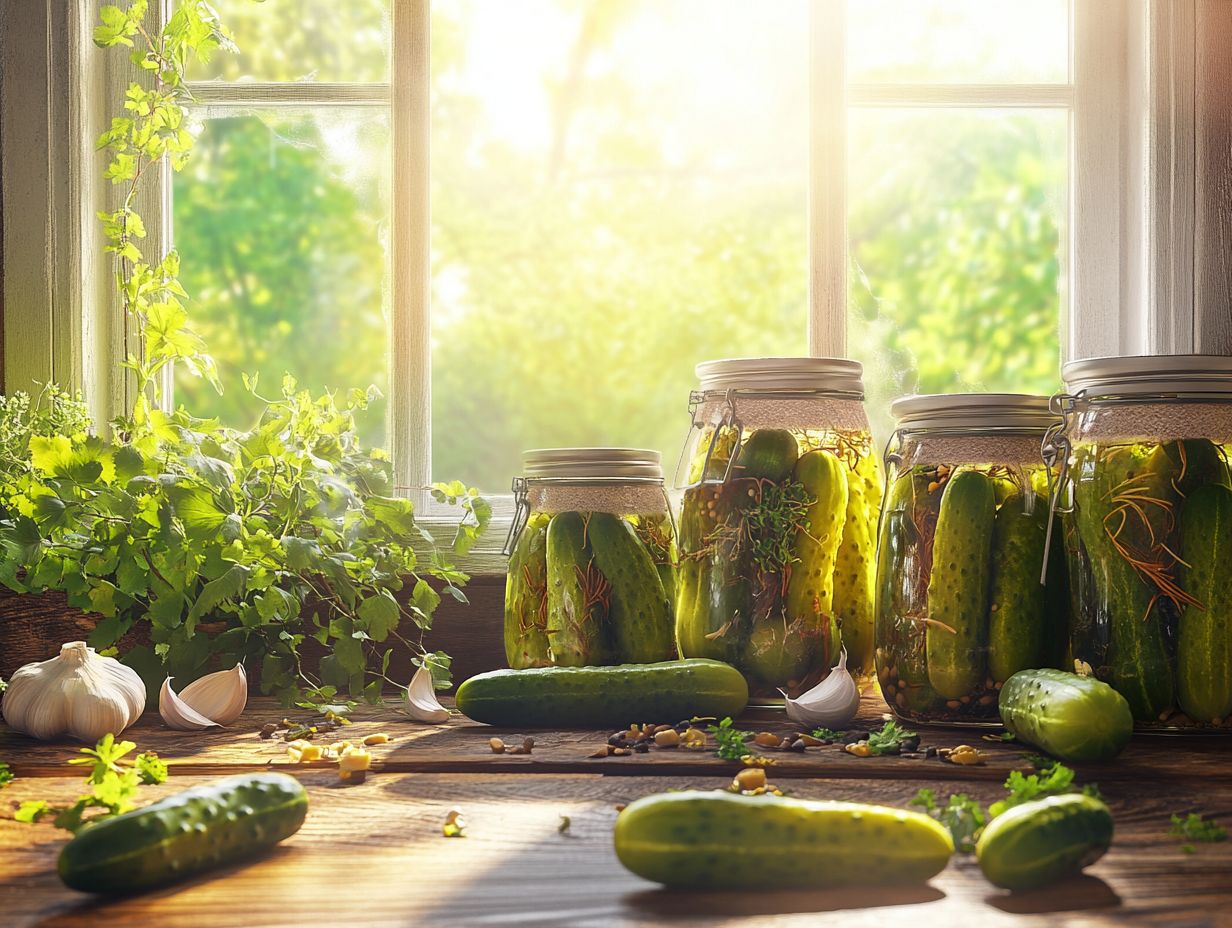
Proper storage techniques for your pickles are essential for maintaining their freshness and flavor. Ensure that the sealed jars are kept in a cool, dark place, away from direct sunlight.
To achieve this, place them in a pantry or a designated storage area. The temperature should remain stable, ideally between 50 to 70 degrees Fahrenheit.
Fluctuations in temperature can lead to spoilage, so it’s important to avoid spots near ovens or heat sources. Maintaining a consistent humidity level is also key to preserving that delightful crisp texture.
Check periodically that the lids remain sealed and that there are no signs of mold. By following these guidelines, you can savor the full, robust taste of your pickles long after they’ve been made.
Troubleshooting Common Pickling Problems
Mastering the art of troubleshooting pickling problems can make your pickles shine! It’s an essential skill for you as a home canner.
Being able to identify and resolve issues with your pickling brine is key to developing flavor for your dill pickles. Many issues might arise during the pickling process, ensuring that your pickles remain safe for enjoyment.
Adhering to recommended canning supplies, like cheesecloth for straining your brine, can greatly help. For more detailed information, check out the best canning practices. Using high-quality ingredients like mustard seed in your pickling spices adds texture and flavor.
Fresh dill enhances the classic taste of kosher dill pickles and elevates your preserving game. Remember, fresh produce and pickling spices can add depth to your flavors!
How to Fix Common Issues
Fixing common issues in pickling requires understanding the potential causes of rotting, texture changes, and flavor imbalances.
Texture changes and flavor imbalances can be corrected by adjusting the recipe, such as adding more salt or sugar. Pay close attention to factors such as salt concentration, especially when using kosher dill or pickling salt.
Monitoring acidity levels is essential. Use appropriate vinegar like apple cider or white vinegar to ensure the right balance.
Your jars should be stored in a location that maintains consistent temperature conditions. This can significantly impact the shelf life of canned goods.
Using the right amount of salt not only enhances flavor but also serves as a preservative. It significantly reduces the risk of unwanted microbial growth.
It’s essential to monitor acidity; insufficient vinegar can lead to fermentation issues or spoilage. Don’t hesitate to experiment with herbs and spices!
A little creativity can transform a bland batch into a vibrant delight. Just remember to balance your seasoning according to your personal preference.
Safety Precautions for Canning Pickles
Implementing safety precautions when canning pickles is absolutely vital to keep your homemade goodies safe! This not only helps prevent contamination but also ensures your homemade preserves are safe for enjoyment. For more detailed information, check out the best practices for canning vegetables.
Use vacuum lids and follow proper canning methods accurately. Additionally, check out how to safely can pickles to ensure that your jars are thoroughly cleaned, making your canned pickles safe.
Using boiling water is an excellent tool for sterilizing canning supplies. Taking these measures transforms your culinary efforts into reliable methods.
The water bath canning method helps achieve successful results. Finally, enjoy the delicious experience that showcases the flavors of fresh dill and garlic.
Now it’s your turn! Try your own pickling adventures and share your experiences in the comments!
Preventing Contamination and Spoilage
Preventing contamination and spoilage of your pickles begins with your commitment to cleaning jars meticulously. Optimal storage conditions include cool, dark places to ensure flavor retention and preserve quality.
To achieve this, employ effective cleaning techniques. Hot, soapy water is essential for cleaning jars before pickling. Follow this with a cleaning solution, like a mixture of vinegar and water or a mild bleach mixture. This approach eliminates lingering bacteria and prepares the jars for the acidity that comes with the pickling process.
Prioritize hygiene when preparing ingredients, such as cucumbers and garlic; by ensuring that both the jars and your workspace are sanitized, you significantly minimize the risk of spoilage. Store these jars in a cool, dark place, away from direct sunlight, to greatly extend their shelf life.
By adhering to these practices, you can enjoy your home-pickled delicacies without the nagging worry of spoilage!
Frequently Asked Questions
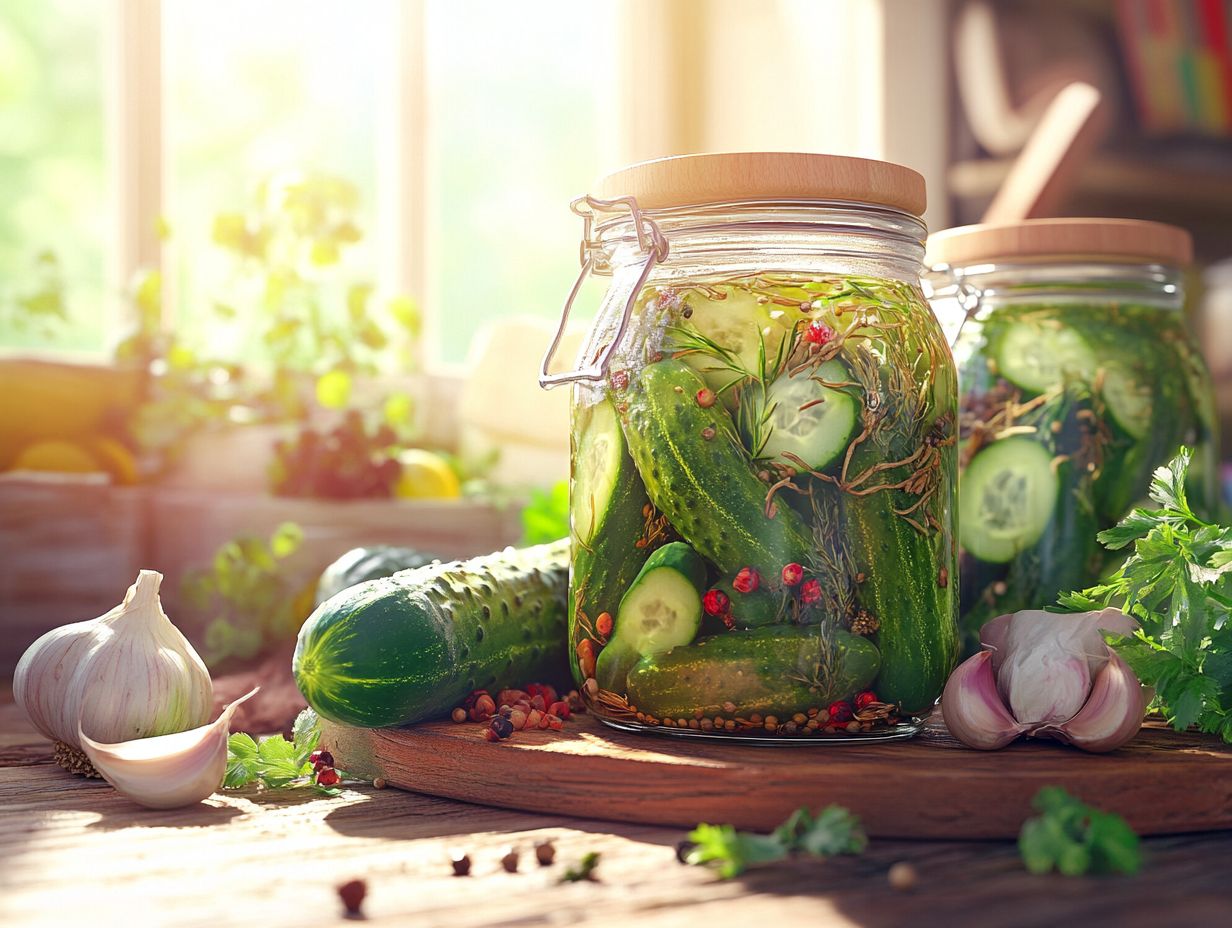
What are the best practices for canning pickles?
1. Start with fresh and high-quality cucumbers. To ensure the best taste and texture, use fresh cucumbers that are firm and free of blemishes or bruises.
2. Use the right type of vinegar. It is recommended to use white vinegar or apple cider vinegar in pickling, as they have the right level of acidity for safe canning.
3. Use pickling salt or canning salt. Regular table salt may contain additives that can cloud the pickling liquid, so it’s best to use pickling or canning salt.
4. Properly sterilize your canning jars. Inspect them for cracks or defects before use. To prevent contamination, thoroughly sterilize your jars and lids by boiling them for 10 minutes.
5. Follow approved canning methods. It’s essential to follow canning techniques for perfect pickles to ensure the safety of your pickles.
6. Store in a cool, dark place. After canning, store your jars in a cool, dark place to maintain the quality and flavor. Refrigerate after opening.
Can I reuse jars and lids for canning pickles?
It is not recommended to reuse jars and lids for canning pickles, as it can result in an imperfect seal and increase the risk of contamination. It’s best to use new jars and lids for each batch of pickles.
How long do canned pickles last?
If properly canned and stored, pickles can last up to one year. However, it’s best to consume them within 6-8 months for the best quality.
What is the importance of using approved canning methods?
Using approved canning methods ensures the safety of your pickles. These methods have been tested and proven to prevent the growth of harmful bacteria that can cause foodborne illnesses, but if you encounter issues, refer to troubleshooting canned pickle problems for guidance.
Can I add any additional seasonings or flavors to my pickles?
Yes, you can add additional seasonings or flavors to your pickles to suit your taste. However, make sure to use tested and approved recipes to maintain the proper acidic level for safe canning.
Can I can pickles without a canner?
While using a canner is the recommended method for safe canning, it is possible to can pickles without one. For those looking for guidance, making dill pickles involves following proper procedures for sterilizing jars and ensuring the correct processing time to prevent potential health risks.

